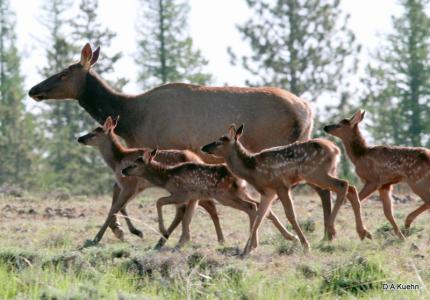Nov. 1, 2021 Update: WDFW made a major update to our Priority Habitats and Species (PHS) map layers for two agency-designated priority habitats: Shrubsteppe and Eastside Steppe. Learn more about the updated maps.
How to find priority habitats and species locations

Use the Priority Habitats and Species (PHS) on the Web app to find information about known locations of priority habitats and species in Washington. Simply navigate to your area, select a project site, and generate a PHS report to show the priority habitats and species near your project site. This information helps landowners and developers design projects that conserve habitat and species and helps local governments decide where to focus habitat conservation efforts. The department recommends a field visit by a WDFW biologist or other professional biologist to make determinations about species presence, absence, or exact location.
Learn how to use the PHS on the Web app.
Maps and digital information
Priority habitats and species locations deemed sensitive by WDFW are not publicly displayed beyond a certain resolution (e.g., township or section) due to an increased risk of human interference. Qualifying landowners, university researchers, government agencies, and tribes may request PHS maps that contain this sensitive data.
Use the PHS Order Form to request standard maps and GIS data. Costs start at $40; final cost depends upon what is ordered.
Maps of at-risk plant species are available from the Department of Natural Resources’ Natural Heritage Program.
How to use PHS information
When PHS records are found in a project area
Contact your local habitat biologist and local planning department to discuss your project. Arrange a site visit with a biologist to review your project area. They can help you plan your project to avoid and minimize harm to priority habitats and species. If impacts are unavoidable, offsetting the harm starts with quantifying the impact (e.g., acres of tree removed, square feet of clearing). With this information, a biologist can then help you determine appropriate mitigation. Learn ways to minimize harm to affected habitats or species in WDFW’s science-based PHS Management Recommendations.
When no PHS records are found in a project area
Finding no PHS records means either a biologist has not surveyed the area, or no priority habitats and species are present. PHS data is only added to the map after field-verification by WDFW biologists or a WDFW-verified professional. There are also some wide-ranging habitats such as riparian, nearshore, in-stream, and snags and logs that are not mapped throughout the state but may exist on the project site. If you think your project site might have unidentified priority habitats or species, call your local habitat biologist or another professional biologist to complete a site survey.
When the PHS report indicates "sensitive" species
The department designates some fish and wildlife data as "sensitive" due to an increased risk of human interference. The location of sensitive data is generalized to the township or section. WDFW biologists and local government staff have access to this sensitive data. Contact your local habitat biologist to discuss whether your project will harm sensitive species. If the sensitive species is on or near your project, you may submit a PHS Order Form and get a map with the specific locations to help you avoid and minimize harm.
Sensitive data is exempt from public disclosure under the Public Records Act; this term is defined in RCW 42.56.430. Sensitive species are any wildlife species likely to become endangered or threatened; this term is defined in WAC 200-200-100. For example, the common loon is a sensitive species because it is at risk of becoming threatened. Their nest sites and habitat areas are not considered sensitive data, therefore common loon nest sites are shown in PHS on the Web.
Map limitations
Although mapped PHS data is useful for determining the general extent of priority species or habitats, the department has not surveyed the entire state of Washington. PHS map data is meant to serve as a starting point to identify priority habitats and species. It is not meant to replace or preempt more detailed field-based, site-level mapping. Site-specific surveys are usually needed to rule out the presence of priority habitats or species. PHS maps do not provide an official agency determination of the potential impacts to fish and wildlife of a specific project.
Contact
Your local habitat biologist can provide site-specific advice. Please contact PHS customer service staff to fulfill requests for standard maps at 360-902-2543.